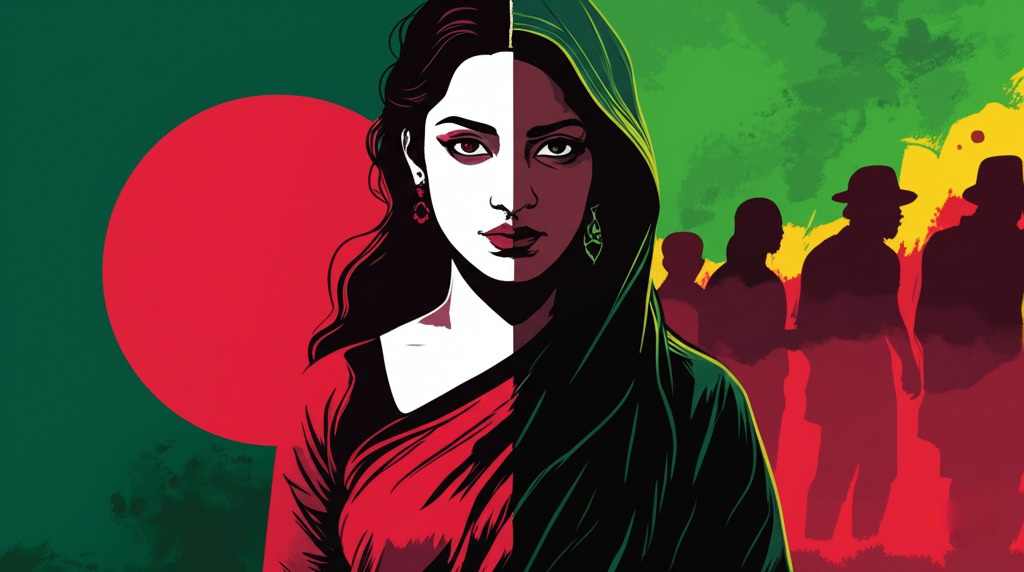There is an unspoken rule in Bangladesh—you can get away with anything, as long as you can morally justify it. In a country that prides itself on progress, empowerment, and inclusivity, a far more sinister reality lurks beneath the surface: one where rape culture is not only normalized but actively nurtured. It is not just about high-profile cases or shocking statistics; it is about the everyday, the seemingly small and insignificant ways in which society conditions women to live in fear and teaches men that they are entitled to power over them. Rape culture is not merely about rape—it encompasses everything that makes sexual violence possible. It is the foundation upon which sexual violence thrives: a system that excuses, justifies, and ultimately enables predatory behavior while placing the burden of prevention on the victims. It accumulates in everyday misogyny—the offhanded jokes about women’s bodies, the policing of their clothing, the unsolicited advice on how they should conduct themselves to avoid “inviting trouble.” It represents a collective failure to recognize that violence does not begin when a man forces himself on a woman; it begins long before, in the invisible ways that society primes women to be victims and men to be perpetrators.
At the heart of Bangladesh’s rape culture lies moral policing of women—a relentless, insidious force that dictates what a woman can wear, where she can go, how loudly she can laugh, and how she must behave to earn the right to exist in public spaces. This form of control, cloaked in the language of protection and respectability, is not about ensuring women’s safety; it is about upholding male dominance. Moral policing is rarely driven by concern for women—it is about controlling them. From the leering uncle on the street to the self-proclaimed moral guardian who justifies harassment in the name of “teaching girls a lesson,” men engage in this behavior because they have been raised to believe that their masculinity is defined by dominance and control. A woman who asserts herself—whether by dressing in a manner that disapproves some, refusing to lower her gaze, or rejecting unwanted advances—becomes a direct threat to this fragile masculinity. And because society has long excused male entitlement, the response is often one of hostility, intimidation, or outright violence.
It is not just men who are complicit; women, too, are conditioned into this system—taught to be enforcers of their own oppression. Mothers warn their daughters not to go out after dark but do not teach their sons about consent. Female teachers scold girls for their outfits instead of holding boys accountable for inappropriate behavior. Within this suffocating environment, rape culture festers, sustained by the silent complicity of an entire society. In schools, boys are rarely taught about respect and boundaries, while girls receive lists of rules on how to “protect themselves.”
In workplaces, women who report harassment are dismissed as troublemakers, their credibility questioned before the perpetrator’s actions are even scrutinized. In families, victims are told to remain silent to avoid dishonoring their relatives, while the men responsible are shielded from consequences and excused as “boys who made a mistake.” The media, too, plays a dangerous role in reinforcing these harmful norms. News reports often focus on what the victim was wearing or whether she was alone, subtly shifting the blame onto her. Movies and television dramas—as discussed on the Film page and various TV-related articles—romanticize toxic male behavior, portraying stalking and harassment as gestures of love. Songs glorify persistence over consent, suggesting that a woman’s “no” is merely a test of determination.
And what about the law? Despite its pretense of justice, the legal system continues to fail women at every turn. It reflects the same patriarchal values that underpin rape culture itself. Survivors who seek justice are met with disbelief, humiliation, and insurmountable barriers. Police officers question them like criminals, demanding proof that they did not, in some way, “provoke” the attack. Courtrooms become battlefields where a woman’s character is scrutinized more than the rapist’s crime. Cases drag on for years, often ending with the accused walking free due to “lack of evidence”—a euphemism for the system’s refusal to take women’s suffering seriously. And what of the bystanders—the so-called “good men” who claim to oppose violence against women but remain silent when their friends make sexist jokes, when their brothers catcall women on the street, or when their colleagues make inappropriate comments in the office? Rape culture is not upheld solely by those who commit violence; it is sustained by those who allow it to continue. Silence is complicity. Indifference is complicity.
Bangladesh prides itself on its progress—more girls in schools, more women in the workforce, more female leaders in positions of power. And yet, none of this progress has dismantled the deeply embedded misogyny that courses through the country’s veins. What good is economic empowerment when women still live in fear? What good is education when it teaches girls to be cautious rather than instructing boys to behave as decent human beings? Women in this country are constantly told what they must do to protect themselves: don’t go out alone, don’t stay out late, don’t wear this, don’t say that, don’t provoke, don’t attract attention, and don’t fight back too hard—or it will only get worse. The message is always clear: if something happens to you, it is your fault for not being careful enough.
Yet the reality remains: women who wear “modest” clothes are harassed. Women who stay home are abused. Women who remain silent are still attacked. Women who follow every single rule continue to be victims of violence. The problem was never women’s behavior—it has always been the entitlement of the men who believe they have a right to harm them. Rape culture flourishes because it is deeply embedded in our social culture. It persists because men are rarely held accountable for their actions and because women are raised to believe that their safety is their responsibility rather than that of those who might protect them. It endures because every time a woman is harassed, threatened, or assaulted, there is a collective effort to minimize, excuse, or justify the violence.
A common phrase resurfaces whenever conversations about rape culture arise: “Not all men.” It is the battle cry of the defensive and the unwilling—of the men who bristle at the mere suggestion that they, too, might be complicit in a system that enables violence. But the issue has never been about all men; it is about enough men. Enough men who laugh at sexist jokes. Enough men who look the other way when their friends behave inappropriately. Enough men who see women as objects rather than equals. Enough men who refuse to acknowledge that rape culture exists at all.
Rape culture is neither an accident nor an anomaly. It is a system deliberately upheld by generations of silence, complicity, and moral policing that punishes women while excusing men. As long as this continues, women in Bangladesh will never truly be free. We have witnessed too many moments of outrage, too many protests—as detailed in various reports on protests—too many hashtags, and too many fleeting conversations that fade away when the next tragedy strikes. And then what? The world moves on—but women do not. They continue to live in a world that constantly reminds them they are not safe. The truth is, rape culture in Bangladesh is not merely a crisis—it is an institution. It thrives because we allow it. It persists because we refuse to name it, challenge it, or dismantle it at its roots.
Until that changes, we will keep asking the same tired questions:
“Why do these things keep happening?”
“Why did she not protect herself?”
“What was she wearing?”
When the real question should be:
“Why do we keep raising men who think they can get away with this?”







